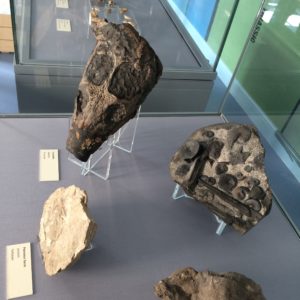It isn’t often that there is an opportunity to engage with something as old as 330 million years but that’s just what we have been doing recently with Scarborough Museums Trust and their new exhibition – Ancient Seas.

Having previously worked on other exhibition displays for the Trust we were approached by them with a requirement to provide display stands for a range of large and small fossils ranging in age from 330 million year crinoids to 65 million year old ammonites. The ammonites ware spectacular and include some that weigh in at 32 Kg and 50 Kg.
The largest ammonite had previously been displayed in a heavy duty forged steel clamp that wrapped around the fossil and was a considerable distraction from the elegance of the sculptural shape.
Our brief was to design and construct free-standing and wall mounted stands for the heaviest items without obscuring their shape and also to enable the stands to display related graphics. We were also asked to provide dedicated clear Perspex stands for a range of other artefacts including fish, starfish, a crocodile skull and an ancient turtle shell.
We surveyed all the fossils and created templates around which we could build the dedicated supports. To do this the templates were scanned and brought into SolidWorks where we could replicate the fossil profiles and develop support profiles to follow the fossil contours.

The larger stands were constructed from birch plywood and were designed to allow the fossils to be embedded in the top panel for stability and security. The stands also had flat side panels for displaying graphics. Finally the fossils were completely restrained by 10mm thick Perspex hold-downs which clamped the fossils in place without obscuring their appearance.
The smaller fossils were supported on clear Perspex stands that were either bonded together from specially shaped profiles or clipped together using interlocking panels.

Which all goes to show that innovative design can be applied as well to incredibly ancient applications as well as modern ones…


 In your dreams… . Ideas do come from dreams, perhaps one of the most fundamental was Niels Bohr when he was inspired to describe the structure of the atom by a dream. You may dream of products, structures, shapes, landscapes, machines…
In your dreams… . Ideas do come from dreams, perhaps one of the most fundamental was Niels Bohr when he was inspired to describe the structure of the atom by a dream. You may dream of products, structures, shapes, landscapes, machines… Competition: “I want one like that” or “ I don’t want one like that” are both powerful drivers for creators of things
Competition: “I want one like that” or “ I don’t want one like that” are both powerful drivers for creators of things
 Working within a defined framework means that designers have more freedom to focus on being creative without having to think too much about the overall process and whether they are on the right track. It’s a bit like going out for a walk and going from waymarker to waymarker. You can explore and admire the view but when you get to the next signpost you know you are on the right route to reach the end.
Working within a defined framework means that designers have more freedom to focus on being creative without having to think too much about the overall process and whether they are on the right track. It’s a bit like going out for a walk and going from waymarker to waymarker. You can explore and admire the view but when you get to the next signpost you know you are on the right route to reach the end.


